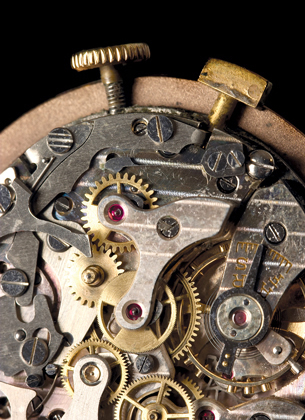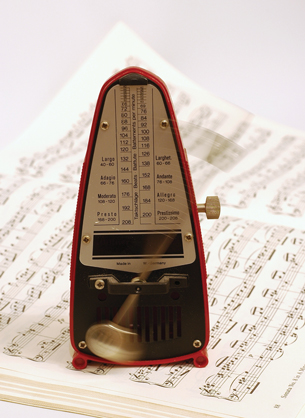Module 7—Oscillatory Motion
 Big Picture
Big Picture

© egd/shutterstock
Passengers are in an airport terminal.
In today’s technologically oriented world, knowing the time is essential. For example, work starts at 8:00, lunch is at 12:00, and the news is on at 6:00. The frozen pizza stays in the oven 24 minutes. The boarding gate opens at 9:30, and the plane to Madrid leaves at 10:05. In the past, being aware of time in such a way would have been impossible. In many places around the world, it would not be considered wise to let time control you instead of the other way around.
Technology has made this awareness to time both possible and inevitable. Without accurate ways to measure and show time, how could we coordinate starting work at 8:00? Having lunch at noon works because the Sun is highest in the sky then, but would people in Edson be eating lunch later than those in Chauvin?
Just how do we keep time accurately enough for the world to function as it does? Basically, it’s as simple as finding something that repeats consistently and regularly. However, it has taken centuries for timekeeping to evolve to its current level of sophistication.

left: © Gareth Leung/shutterstock
centre: © 2007 Jupiterimages Corporation
right: © 2007 Jupiterimages Corporation
The repeating pattern was clear in each device that was used, and the length of time for one repetition was usually smaller as each new device was created. The sundial took a day to complete one repetition; the hourglass took an hour; and, depending on when they were constructed, large community clocks took an hour or less.

© Paul B. Moore/shutterstock
Once, time-keeping devices were not commonplace. The grandfather clocks shown here used a pendulum as the source of the regular, repeating pattern. However, the pendulum had its drawbacks. These clocks were so large that you couldn’t take them with you when you went out; and even when smaller clocks were developed, they would not keep time unless they were stationary. The motion of carrying the clock interfered with the motion of the pendulum. Eventually the pendulum was replaced with new technologies. Metallurgy and tool making also advanced to the point that small timepieces that are easily worn were available.
Those evenly spaced, repetitive events that gave us time and clocks are useful in other ways too. Have you ever taken music lessons?
If so, you will have learned how important the tempo of the music you are playing is. Time is an important part of western music. The length of each note is an integral part of the song. If you change the lengths of some notes and not others, it just doesn’t sound right. The simple metronome that creates a steady beat can help you play music just the way the composer intended it to be played.

© Anyka/shutterstock

© Ariel Schrotter/shutterstock
Is that the only place that steady, repetitive events come into music? Actually, no. The very sound that you are making is made up of waves that repeat similar patterns hundreds of times for each note you play.
All of the musicians in these pictures use repetition—to get to the concert on time, to define the tempo of their music, and to create vibrations that initiate sound waves—in making music that their fans enjoy.

left; © Andreas Gradin/shutterstock
right: © Losevsky Pavel/shutterstock
As you work through this module, keep the following questions in mind. They should help you better understand oscillatory motion in your world.
- What is oscillatory motion?
- What is simple harmonic motion?
- What is the equation for the period of a weighted spring?
- How is simple harmonic motion related to circular motion?
- Is the motion of a pendulum simple harmonic motion?
- What is the equation for the period of a pendulum?
- How is the restoring force of a pendulum determined?
- How is simple harmonic motion related to circular motion?
- What is a resonant frequency?
- What is mechanical resonance?
- Are there examples of mechanical resonance in your everyday world?